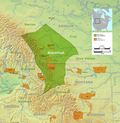
The Crow, whose autonym is Apsáalooke, also spelled Absaroka, are Native Americans living primarily in southern Montana. Today, the Crow people have a federally recognized tribe, the Crow Tribe of Montana, with an Indian reservation located in the south-central part of the state.

The Arapaho are a Native American people historically living on the plains of Colorado and Wyoming. They were close allies of the Cheyenne tribe and loosely aligned with the Lakota and Dakota.

The Blackfoot Confederacy, Niitsitapi or Siksikaitsitapi, is a historic collective name for linguistically related groups that make up the Blackfoot or Blackfeet people: the Siksika ("Blackfoot"), the Kainai or Blood, and two sections of the Peigan or Piikani – the Northern Piikani (Aapátohsipikáni) and the Southern Piikani. Broader definitions include groups such as the Tsúùtínà (Sarcee) and A'aninin who spoke quite different languages but allied with or joined the Blackfoot Confederacy.

The Cypress Hills are a geographical region of hills in southwestern Saskatchewan and southeastern Alberta, Canada. The hills are part of the Missouri Coteau upland.

Big Bear, also known as Mistahi-maskwa, was a powerful and popular Cree chief who played many pivotal roles in Canadian history. He was appointed to chief of his band at the age of 40 upon the death of his father, Black Powder, under his father's harmonious and inclusive rule which directly impacted his own leadership. Big Bear is most notable for his involvement in Treaty 6 and the 1885 North-West Rebellion; he was one of the few chief leaders who objected to the signing of the treaty with the Canadian government. He felt that signing the treaty would ultimately have devastating effects on his nation as well as other Indigenous nations. This included losing the free nomadic lifestyle that his nation and others were accustomed to. Big Bear also took part in one of the last major battles between the Cree and the Blackfoot nations. He was one of the leaders to lead his people against the last, largest battle on the Canadian Plains.
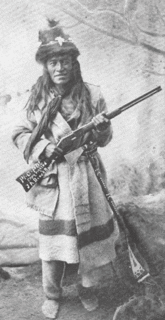
Piapot, Payipwât, or Payipwat, born as Kisikawasan, known by his Assiniboine allies as Maȟpíya owáde hókši was a Native Canadian chief of the Cree-Assiniboine / Young Dogs Band, a mighty band and division of the Downstream People (Māmihkiyiniwak) of the Plains Cree. He was one of the five major leaders of the Plains Cree after 1860.
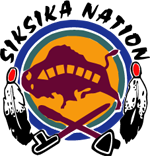
The Siksika Nation is a First Nation in southern Alberta, Canada. The name Siksiká comes from the Blackfoot words sik (black) and iká (foot), with a connector s between the two words. The plural form of Siksiká is Siksikáwa. The Siksikáwa are the northernmost of the Niitsítapi, all of whom speak dialects of Blackfoot, an Algonquian language.

The Piikani Nation is a First Nation, representing the Indigenous people in Canada known as the Northern Piikani or simply the Peigan.

Crowfoot or Isapo-Muxika was a chief of the Siksika First Nation. His parents, Istowun-eh'pata and Axkahp-say-pi, were Kainai. He was five years old when Istowun-eh'pata was killed during a raid on the Crow tribe, and, a year later, his mother remarried to Akay-nehka-simi of the Siksika people among whom he was brought up. Crowfoot was a warrior who fought in as many as nineteen battles and sustained many injuries, but he tried to obtain peace instead of warfare. Crowfoot is well known for his involvement in Treaty Number 7 and did much negotiating for his people. While many believe Chief Crowfoot had no part in the North-West Rebellion, he did in fact participate to an extent due to his son's connection to the conflict. Crowfoot died of tuberculosis at Blackfoot Crossing on April 25, 1890. Eight hundred of his tribe attended his funeral, along with government dignitaries. In 2008, Chief Crowfoot was inducted into the North America Railway Hall of Fame where he was recognized for his contributions to the railway industry. Crowfoot is well known for his contributions to the Blackfoot nation, and has many memorials to signify his accomplishments.

Jeremiah “Jerry” Potts, , was an American - Canadian plainsman, buffalo hunter, horse trader, interpreter, and scout of Kainai (Blood) and Scots heritage.

The Assiniboine or Assiniboin people, also known as the Hohe and known by the endonym Nakota, are a First Nations/Native American people originally from the Northern Great Plains of North America.
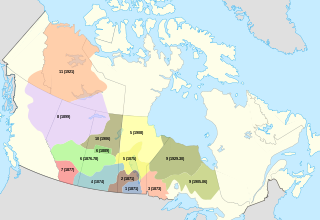
Treaty 7 is an agreement between the Crown and several, mainly Blackfoot, First Nation band governments in what is today the southern portion of Alberta. The idea of developing treaties for Blackfoot lands was brought to Blackfoot chief Crowfoot by John McDougall in 1875. It was concluded on September 22nd, 1877 and December 4th, 1877. The agreement was signed at the Blackfoot Crossing of the Bow River, at the present-day Siksika Nation reserve, approximately 100 km (62 mi) east of Calgary, Alberta. Chief Crowfoot was one of the signatories to Treaty 7. Another signing on this treaty occurred on December 4, 1877 to accommodate some Blackfoot leaders who were not present at the primary September 1877 signing.
First Nations in Alberta are a group of people who live in the Canadian province of Alberta. The First Nations are peoples recognized as Indigenous peoples or Plains Indians in Canada excluding the Inuit and the Métis. According to the 2011 Census, a population of 116,670 Albertans self-identified as First Nations. Specifically there were 96,730 First Nations people with registered Indian Status and 19,945 First Nations people without registered Indian Status. Alberta has the third largest First Nations population among the provinces and territories. From this total population, 47.3% of the population lives on an Indian reserve and the other 52.7% live in urban centres. According to the 2011 Census, the First Nations population in Edmonton totalled at 31,780, which is the second highest for any city in Canada. The First Nations population in Calgary, in reference to the 2011 Census, totalled at 17,040. There are 48 First Nations or "bands" in Alberta, belonging to nine different ethnic groups or "tribes" based on their ancestral languages.

The modern history of Lethbridge extends to the mid-19th century, when the area was developed from drift mines opened by Nicholas Sheran in 1874, and the North Western Coal and Navigation Company in 1882. Prior to the development of drift mines in the area, Lethbridge, Alberta was known as Coal Banks, and was part of the territory of the Blackfoot Confederacy. The Confederacy was made up of the Kainai Nation, the Northern Peigan, the Southern Peigan (Blackfeet), and the Siksika Nation.
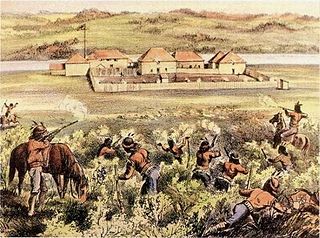
Fort Pitt Provincial Park is a provincial park in the Canadian province of Saskatchewan. Fort Pitt was a fort built in 1829 by the Hudson's Bay Company (HBC) that also served as a trading post on the North Saskatchewan River in Rupert's Land. It was built at the direction of Chief Factor John Rowand, previously of Fort Edmonton, in order to trade for bison hides, meat and pemmican. Pemmican, dried buffalo meat, was required as provisions for HBC's northern trading posts.
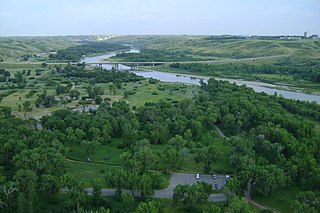
Indian Battle Park is a park located in the Oldman River valley urban park system of Lethbridge, Alberta. The 150-acre (0.61 km2) park was developed in 1960 and commemorates the Battle of the Belly River held in the area on 24 October 1870 between the Blackfoot and the Cree. A formal peace treaty between the two nations was reached in 1871.
The Iron Confederacy or Iron Confederation was a political and military alliance of Plains Indians of what is now Western Canada and the northern United States. This confederacy included various individual bands that formed political, hunting and military alliances in defense against common enemies. The ethnic groups that made up the Confederacy were the branches of the Cree that moved onto the Great Plains around 1740, the Saulteaux, the Nakoda or Stoney people also called Pwat or Assiniboine, and the Métis and Haudenosaunee. The Confederacy rose to predominance on the northern Plains during the height of the North American fur trade when they operated as middlemen controlling the flow of European goods, particularly guns and ammunition, to other Indigenous nations, and the flow of furs to the Hudson's Bay Company (HBC) and North West Company (NWC) trading posts. Its peoples later also played a major part in the bison (buffalo) hunt, and the pemmican trade. The decline of the fur trade and the collapse of the bison herds sapped the power of the Confederacy after the 1860s, and it could no longer act as a barrier to U.S. and Canadian expansion.

Sweet Grass was a chief of the Cree in the 1860s and 1870s in western Canada. He worked with other chiefs and bands to participate in raids with enemy tribes. While a chief, Sweet Grass noticed the starvation and economic hardship the Cree were facing. This propelled him to work with the Canadian and eventually sign Treaty Six. Sweet Grass believed that working alongside the government was one of the only solutions to the daily hardship the Cree were faced with. The Sweet Grass Reserve west of Battleford, Saskatchewan was named in his honor and is still functioning today.
Maskepetoon was a renowned Cree leader and warrior. He was a highly respected peace-maker, due to his negotiation of truces between the Cree and other First Nations. It has been said by Hugh Dempsey that even during Maskepetoon's youth, he was an intelligent child and showed leadership. After leaving the care of his mother, Maskepetoon began to study the necessary skills of hunting and trapping. In the early to mid 1820s, his tribe struggled with starvation as well as ongoing conflict. This meant that Maskepetoon would have had to take up the role of a soldier, being put in positions of guarding the camp and scouting for any potential threats. Dempsey has also noted that Maskepetoon eventually chose peace over war following a visit to a holy man. He was said to have been spoken to by his father on the issue, his father telling him that he did not have to choose war. Despite being spoken to several times, Maskepetoon rejected his talk of peace. However, the talks with his father began to bother him, so he visited a holy man who laid out two paths for Maskepetoon, war or peace. Following these words with the holy man, Maskepetoon had finally found peace to be the favourable choice. Throughout his life, Maskepetoon married an estimated four times.

Mountain Chief was a South Piegan warrior of the Blackfoot Tribe. Mountain Chief was also called Big Brave (Omach-katsi) and adopted the name Frank Mountain Chief. Mountain Chief was involved in the 1870 Marias Massacre, signed the Treaty of Fort Laramie in 1868, and worked with anthropologist Frances Densmore to interpret folksong recordings.

















